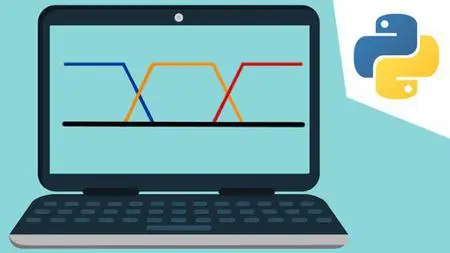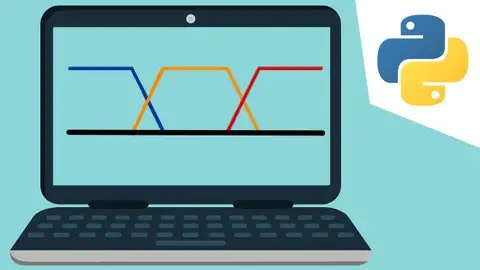The Ultimate Beginners Guide To Fuzzy Logic In Python
Published 7/2022
MP4 | Video: h264, 1280x720 | Audio: AAC, 44.1 KHz
Language: English | Size: 1.15 GB | Duration: 4h 8m
Published 7/2022
MP4 | Video: h264, 1280x720 | Audio: AAC, 44.1 KHz
Language: English | Size: 1.15 GB | Duration: 4h 8m
Understand the basic theory and implement fuzzy systems with skfuzzy library! Step by step implementations
What you'll learn
Understand the theoretical concepts of fuzzy logic, such as: linguistic variables, antecedents, consequent, membership, fuzzification, and defuzzification
Learn defuzzification calculations using the following methods: centroid, bisector, MOM, SOM and LOM
Implement fuzzy systems using skfuzzy library
Simulate a fuzzy system to choose the percentage of tip that would be given in a restaurant
Simulate a fuzzy system to adjust the suction power of a vacuum cleaner, according to the type of surface and amount of dirt
Implement data clustering using the fuzzy c-means algorithm
Requirements
Basic Python programming
Description
Fuzzy Logic is a technique that can be used to model the human reasoning process in computers. It can be applied to several areas, such as: industrial automation, medicine, marketing, home automation, among others. A classic example is the use in industrial equipments, which can have the temperature automatically adjusted as the equipment heats up or cools down. Other examples of equipments are: vacuum cleaners (adjustment of suction power according to the surface and level of dirt), dishwashers and clothes washing machines (adjustment of the amount of water and soap to use), digital cameras (automatic focus setting), air conditioning (temperature setting according to the environment), and microwave (power adjustment according to the type of food).In this course, you will learn the basic theory of fuzzy logic and mainly the implementation of simple fuzzy systems using skfuzzy library. All implementations will be done step by step using the Python programming language! Below you can see the main content, which is divided into three parts:Part 1: Basic intuition about fuzzy logic. You will learn topics such as: linguistic variables, antecedents, consequent, membership functions, fuzzification and mathematical calculations for defuzzificationPart 2: Implementation of fuzzy systems. You will implement two examples: the calculation of tips that would be given in a restaurant (based on the quality of the food and the quality of service) and the calculation of the suction power of a vacuum cleaner (based on the type of surface and the amount of dirt )Part 3: Clustering with fuzzy c-means algorithm. We will cluster a bank's customers based on the credit card limit and the total bill. You will understand how fuzzy logic can be applied in the area of Machine LearningAll implementations will be done step by step using Google Colab on-line, so you don't need to worry about installing the libraries on your own machine. At the end, you will be able to create your own projects using fuzzy logic!
Overview
Section 1: Introduction
Lecture 1 Course content
Lecture 2 Course materials
Section 2: Basic intuition
Lecture 3 Plan of attack
Lecture 4 Applications of fuzzy logic
Lecture 5 First understanding
Lecture 6 Linguistic variables and membership
Lecture 7 Steps for fuzzy inference
Lecture 8 Defuzzification - calculation
Section 3: Fuzzy control systems - implementation
Lecture 9 Plan of attack
Lecture 10 Tipping problem 1 - libraries
Lecture 11 Tipping problem 2 - antecedents and consequent
Lecture 12 Tipping problem 3 - membership functions
Lecture 13 Tipping problem 4 - rules
Lecture 14 Tipping problem 5 - defuzzification
Lecture 15 Fuzzy functions - sigmoid, gaussian and PI
Lecture 16 HOMEWORK - vacuum cleaner problem 1
Lecture 17 Vacuum cleaner problem 2
Lecture 18 Vacuum cleaner problem 3
Lecture 19 Tipping problem - hard fuzzy 1
Lecture 20 Tipping problem - hard fuzzy 2
Lecture 21 Tipping problem - hard fuzzy 3
Lecture 22 Tipping problem - hard fuzzy 4
Lecture 23 Tipping problem - hard fuzzy 5
Lecture 24 Tipping problem - hard fuzzy 6
Lecture 25 Tipping problem - hard fuzzy 7
Lecture 26 Tipping problem - hard fuzzy 8
Lecture 27 Other defuzzification methods
Section 4: Clustering with fuzzy c-means
Lecture 28 Plan of attack
Lecture 29 Clustering - intuition
Lecture 30 Loading the dataset
Lecture 31 Preprocessing the dataset
Lecture 32 Clustering with fuzzy c-means
Section 5: Final remarks
Lecture 33 Final remarks
Anyone interested in fuzzy logic,Students who are taking courses on Artificial Intelligence or Data Science,Data Scientists who want to increase their knowledge in artificial intelligence algorithms



